Tunisian Simple Stitch
Like regular crochet, every project worked in Tunisian crochet begins with a foundation chain from which a row of stitches is picked up and held along the shank of the hook/needle. To work a practice swatch, make a chain of twenty stitches. Then work the first row as follows:
• Foundation Row (pick up stitches): Insert the hook through the top loop of the second chain from the hook (Figure 1), yarn over and draw a loop through (2 stitches on hook). *Insert the hook into the top loop of the next chain stitch and draw a loop through, leaving it on the hook. Repeat from *, drawing 1 loop through each chain stitch. When you reach the end of the chain, you should have 20 loops on your hook—one for each chain stitch.
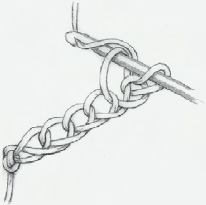
Figure 1
• Reverse Row (complete the stitch): Yarn over the hook and draw a loop through the first loop on the hook (Figure 2). This single stitch is the equivalent of 1 turning chain; it brings the hook up to the level of the next row. *Yarn over and bring the hook through 2 stitches (Figure 3). Repeat from * to end of row. As you work from left to right, you’ll bind off a stitch each time you draw a loop through the 2 loops on the hook. You will end with 1 loop on the needle—this loop counts as the first stitch of the next row.
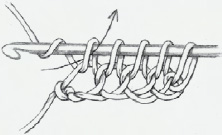
Figure 2
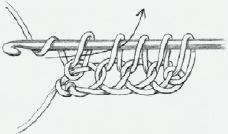
Figure 3
• Forward Row (pick up stitches): *Bring the hook from right to left under the first vertical bar created by the first 2 rows (Figure 4) and draw a loop through (Figure 5), leaving it on the hook. Rep from * to end of row, drawing up a loop from under the last vertical strand.
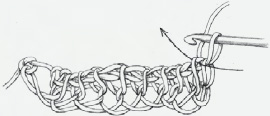
Figure 4
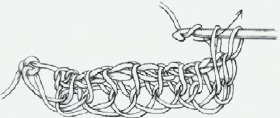
Figure 5
Work a forward row followed by a reverse row for Tunisian simple stitch. After a few rows, look closely at the fabric you’ve made. You’ll see a series of short stacked vertical lines, separated by what looks like sideways Vs or chain stitches.
Tunisian Purl Stitch
Just like knitting, Tunisian crochet can be worked with “purl” rows for a more textured effect. The yarn is held in front of the work on the first forward row to create horizontal bumps. The second row of the sequence, a reverse row, is worked just as for Tunisian simple stitch.
• Forward Row (pick up stitches): Bring the yarn to the front of your work, holding it below and in front of the hook. *Insert the hook from right to left through the first vertical strand, as in the second pass of the forward row of the simple stitch. Yarn over by bringing the yarn up, behind, and then over the hook from back to front (Figure 6). Draw a loop through, leaving it on the hook. Repeat from *. As you work from one vertical strand to the next, the yarn you’re working with will lie over the vertical strand being worked.
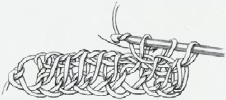
Figure 6
• Reverse Row (complete the stitch): Work as for the reverse row of Tunisian simple stitch.
When you look at the fabric made with Tunisian purl stitch, you’ll still see the vertical lines made in simple stitch, but this time they will be interrupted by short horizontal bumps made from the strand of yarn that crosses over the vertical strands as you work.
Increasing
To increase a stitch at the beginning of a forward row (worked right to left), pick up an extra loop by inserting the hook from front to back under the horizontal strand that lies between the loop on the hook and the first vertical strand (Figure 7), then yarn over and pull a loop through. Work as usual in the next vertical strand. To increase at the other end of the row, pull an extra loop by inserting the hook under the last horizontal strand in the row, just before the last vertical strand.
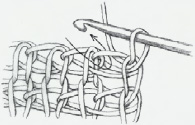
Figure 7
Decreasing
To decrease a stitch, insert the hook under two vertical strands at the same time (Figure 8), yarn over and draw a loop through both strands.
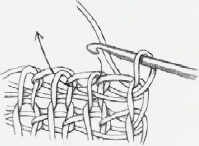
Figure 8
Always start and end each row with a sc.
Rep Row 2 for patt.
1 row with A, 1 row with B, 1 row with C. Rep these 3 rows for patt.
Inc 2 by working (sc, ch 1, sc) in st indicated.
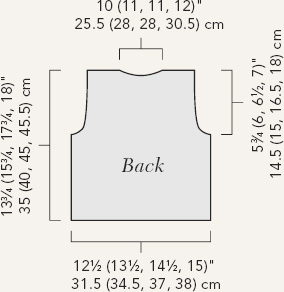

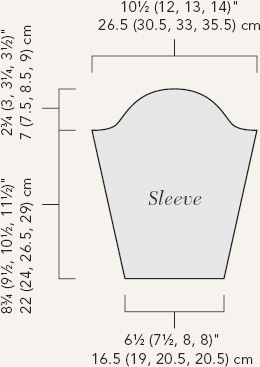
Back
With larger hook and A, ch 51 (55, 59, 61).
ROW 1: Work Row 1 of granite st patt (see Stitch Guide, page 74), turn.
ROW 2: Join B. Work Row 2 of granite st patt, turn.
Cont in st patt and color patt until piece measures 7¾ (9¼, 10½, 10½)" (19.5 [23.5, 26.5, 26.5] cm).
Shape armhole
ROW 1: (RS) Sl st in first 3 (3, 4, 4) sts, ch 1, cont in est patt to last 3 (3, 4, 4) sts, leave rem sts unworked, turn—44 (48, 50, 52) sts.
Sizes 27½ (29½)" (70 [75] cm) only
On next row, sl st in first st, ch 1, cont in est patt to last st, turn, leaving rem st unworked—46 (48) sts.
All sizes
Work 1 edge dec (see Stitch Guide) at each side every 2nd row, 2 times, then every 4th row 1 (1, 1, 2) time(s)—38 (40, 42, 44) sts. Cont in patt until piece measures 13½ (15¼, 17, 17½)" (34 [39, 43, 44.5] cm).
Shape back neck
ROW 1: (RS) Work 12 (13, 14, 15) sts in est patt, sl st in next 14 sts, work rem 12 (13, 14, 15) sts in patt, turn.
Cont working each side of neck separately.
Left neck and shoulder
ROW 1: Work 9 (10, 11, 12) sts in est patt, dbl dec (see Stitch Guide) over rem 3 sts, turn—10 (11, 12, 13) sts.
Work even in patt for 1 (1, 2, 1) rows. Fasten off.
Right neck and shoulder
ROW 1: Join yarn in first st of Row 1 of back neck, dbl dec over first 3 sts, cont in est patt across, turn—10 (11, 12, 13) sts. Work even in patt for 1 (1, 2, 1) rows. Fasten off.
Left Front
With larger hook and A, ch 25 (27, 29, 31). Work granite st in color patt until work measures 7¾ (9¼, 10½, 10½)" (19.5 [23.5, 26.5, 26.5] cm).
Shape armhole
ROW 1: (RS) Sl st in each of first 3 (3, 4, 4) sts, ch 1, cont in granite st patt across, turn—21 (23, 24, 26) sts.
ROW 2: Work even in patt, turn. Work 1 edge dec (see Stitch Guide) at armhole edge every RS row 2 (3, 3, 2) times—19 (20, 21, 24) sts.
Work 1 edge dec at armhole edge every 4th row 1 (1, 1, 2) time(s)—18 (19, 20, 22) sts. Work even in patt until work measures 12 (14, 16, 16)" (30.5 [35.5, 40.5, 40.5] cm), ending with WS row.
Shape front neck:
NEXT ROW: (RS) Work in patt, using edge dec, dec 2 (2, 2, 3) sts for neck—16 (17, 18, 19) sts. On foll row, work granite st patt to last 4 sts, dbl dec, sc in last st—14 (15, 16, 17) sts.
Work in granite st patt to last 4 sts, dbl dec, sc in last st every 2nd row 2 times—10 (11, 12, 13) sts. Cont in granite st patt until piece measures same length as back. Fasten off.
Right Front
With larger hook and A, ch 25 (27, 29, 31). Work in granite st and color patt until piece measures 7¾ (9¼, 10½, 10½)" (19.5 [23.5, 26.5, 26.5] cm).
Shape armhole
ROW 1: (RS) Work in patt to last 3 (3, 4, 4) sts, turn, leaving rem sts unworked—21 (22, 24, 26) sts.
Work 1 edge dec at armhole edge 2 (3, 3, 2) times—19 (20, 21, 24) sts. Then work 1 edge dec st every 4th row at armhole edge 1 (1, 1, 2) time(s)—18 (19, 20, 22) sts. Work even in patt until work measures 12 (14, 16, 16)" (30.5 [35.5, 40.5, 40.5] cm).
Shape front neck
Using edge dec, dec 2 (2, 2, 3) sts at beg of row for neck—16 (17, 18, 19) sts. On foll row, dbl dec at neck—14 (15, 16, 17) sts. Dbl dec at neck edge every 2nd row 2 times—10 (11, 12, 13) sts.
Cont until piece measures same length as back. Fasten off.
Sleeves
With larger hook and A, ch 27 (31, 33, 33). Foll the color patt.
Size 27½" (70 cm) only:
Work 3 rows in patt st.
NEXT ROW: Work 14 sts in patt, [2 sc in next st] twice, work in patt across—32 sts.
All sizes:
Work 7 (7, 7, 5) rows even in patt.
NEXT ROW: Dbl inc in first st (see Stitch Guide, page 74), work in patt to last st, dbl inc—30 (36, 36, 36). Cont in patt, double inc at each end every 8th (8th, 8th, 6th) row 3 (3, 4, 5) times—42 (48, 52, 56) sts. Work even in patt until work measures 8¾ (9½, 10½, 11½)" (22 [24, 26.5, 29] cm).
Shape sleeve cap
ROW 1: Sl st in first 3 (5, 5, 5) sts, work in patt to last 3 (5, 5, 5) sts, turn, leaving rem sts unworked—36 (38, 42, 46) sts.
Using edge dec, dec 2 sts at each edge every 2nd row 3 times—24 (26, 30, 34) sts. Work 2 (2, 2, 1) row(s) even in patt. Using edge dec, dec 2 sts at each side every 2nd row 3 (1, 1, 1) time(s)—12 (22, 26, 30) sts.
Size 25½" (65 cm) only:
Fasten off.
Sizes 27½ (29½, 30¾)" (70 [75, 77.5] cm) only:
Work 1 (1, 2) row(s) even in patt. Using edge dec, dec 2 sts at each side every 2nd row 2 (3, 4) times—14 (14, 14) sts.
Size 29½" (75 cm) only:
Work 1 row even in patt.
Sizes 27½ (29½, 30¾)" (70 [75, 77.5] cm) only:
Fasten off.
Finishing
With smaller hook, A, and WS facing, join yarn with sl st to right-front neck edge.
ROW 1: Ch 1, sc in each st to hem edge, turn.
ROW 2: Ch 1, sc in first st, sc in each st to neck edge. Fasten off.
Rep Rows 1–2 for left front, beg with hem edge. Block pieces lightly, if needed. With yarn needle and A, sew shoulder seams and side seams.
Collar
ROW 1: With smaller hook, A, and WS facing, join yarn with sl st to left-front neck edge, ch 1, sc in same st, sc in each st across to right-front neck edge, turn.
ROW 2: Ch 1, sc in each sc across, turn.
Rep Row 2 until collar measures 2¼ (2¾, 2¾, 3¼)" (6 [7, 7, 8] cm). Fasten off and weave in loose ends. Block collar. With sewing needle and matching sewing thread, sew in zipper. With yarn needle and A, sew sleeve seams. Sew sleeves in armholes.
Annette Petavy dreams up crochet designs at her home near Lyon, France. See more of her work at annettepetavy.com.









 ): #4045 blue (A), 1 (2, 2, 2) skeins; #0174 red (B), 1 (1, 2, 2) skeins; #0054 green (C), 1 (1, 2, 2) skeins.
): #4045 blue (A), 1 (2, 2, 2) skeins; #0174 red (B), 1 (1, 2, 2) skeins; #0054 green (C), 1 (1, 2, 2) skeins.
 Stitch totals given at the end of a row include each chain-one and single crochet.
Stitch totals given at the end of a row include each chain-one and single crochet.

